Economic Equilibrium in Australia: Factors and Stability Analysis
VerifiedAdded on 2019/10/30
|5
|1384
|350
Essay
AI Summary
This essay delves into the concept of economic equilibrium, focusing on its application to the Australian economy. It begins with an introduction to economic equilibrium, defining it as the point where demand and supply are balanced, leading to stable prices and quantities. The essay then explores the dynamics of stable equilibrium and the challenges in achieving it, considering factors like excess demand, supply deficits, and external shocks. The core of the analysis centers on the Australian economy, examining its stability, influenced by factors such as government policies, fiscal and monetary tools, and structural reforms. The essay highlights Australia's strong economic performance, characterized by robust GDP growth, low unemployment, and controlled inflation, while acknowledging potential instability from external factors. The conclusion reinforces the stability of the Australian economy, supported by government policies and favorable economic indicators, making it a valuable case study for understanding economic equilibrium in practice.
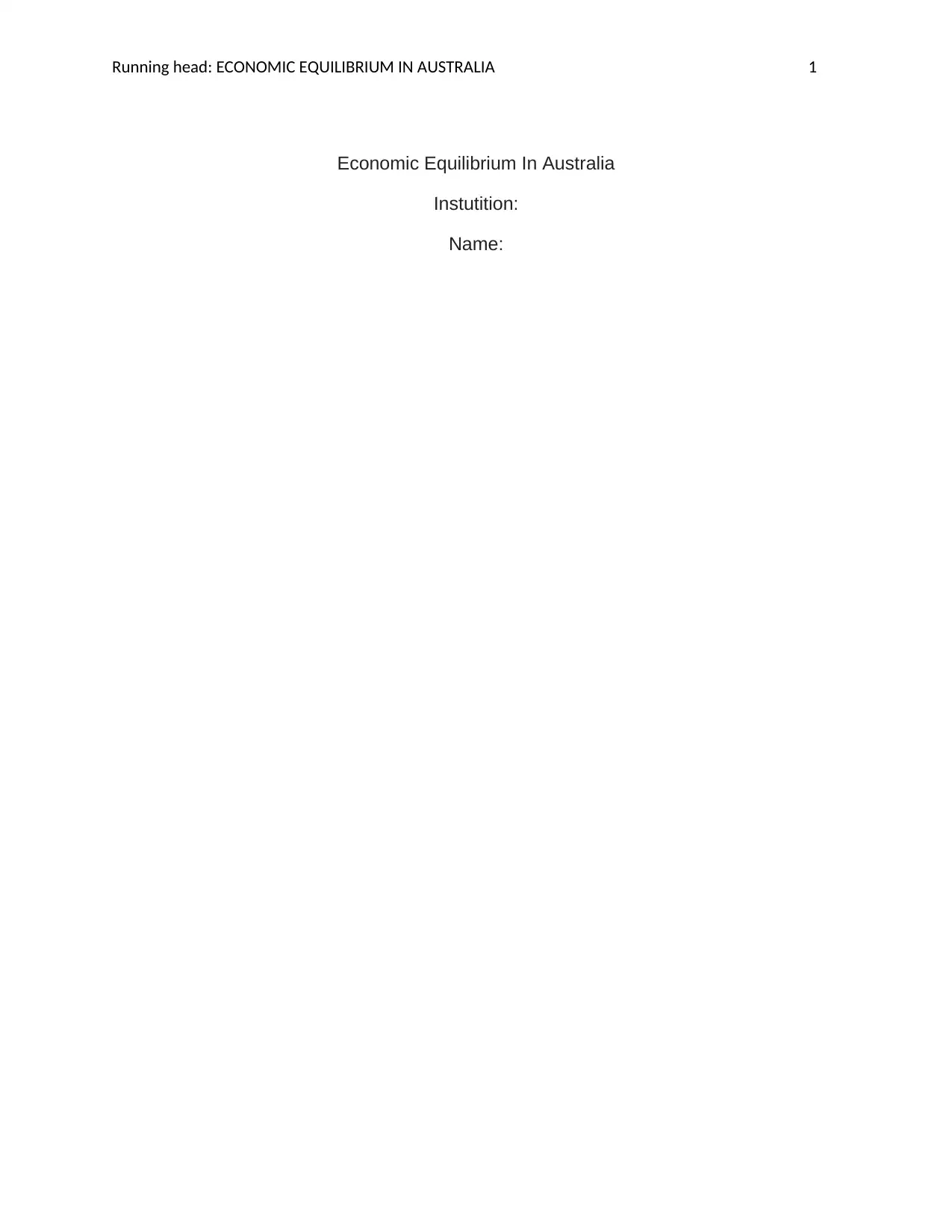
Running head: ECONOMIC EQUILIBRIUM IN AUSTRALIA 1
Economic Equilibrium In Australia
Instutition:
Name:
Economic Equilibrium In Australia
Instutition:
Name:
Paraphrase This Document
Need a fresh take? Get an instant paraphrase of this document with our AI Paraphraser
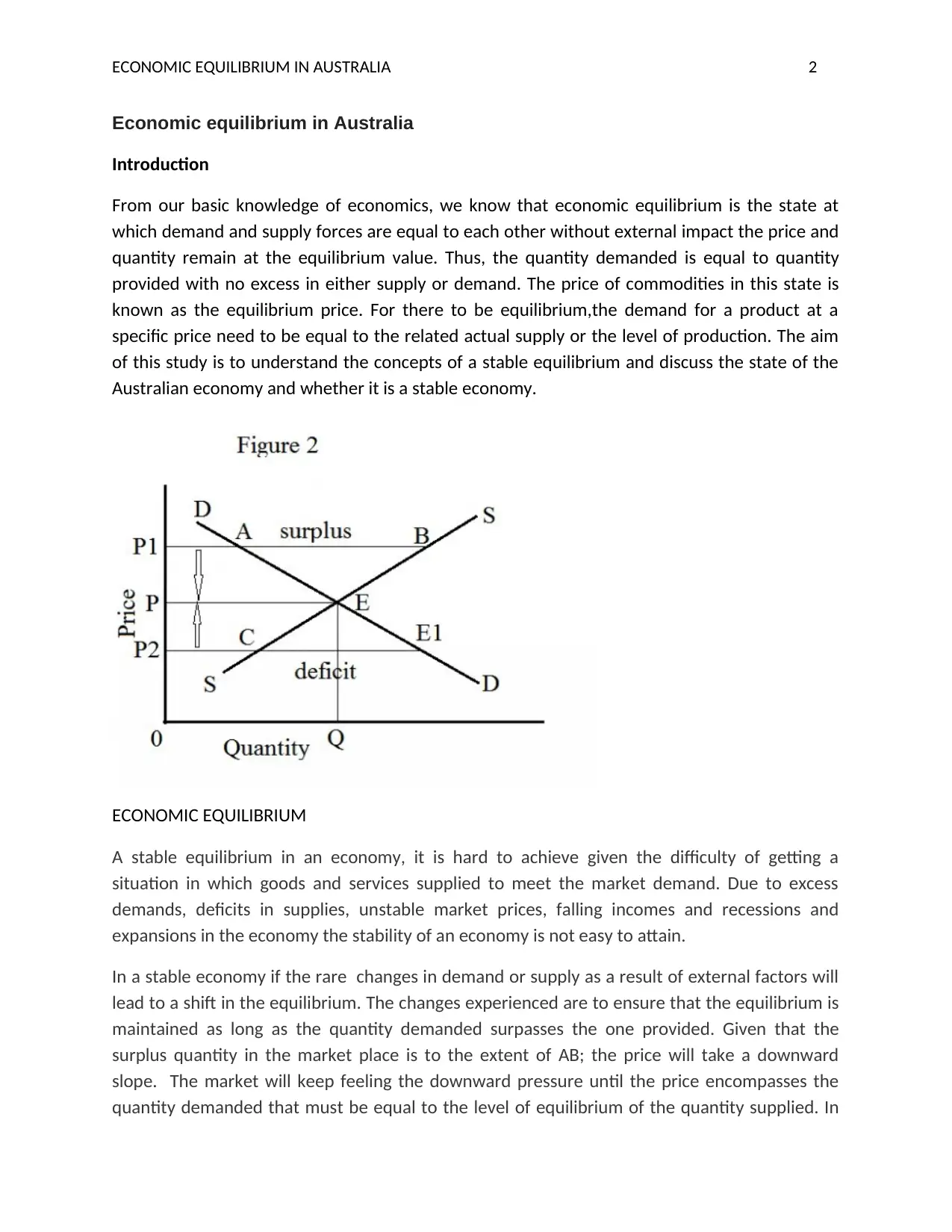
ECONOMIC EQUILIBRIUM IN AUSTRALIA 2
Economic equilibrium in Australia
Introduction
From our basic knowledge of economics, we know that economic equilibrium is the state at
which demand and supply forces are equal to each other without external impact the price and
quantity remain at the equilibrium value. Thus, the quantity demanded is equal to quantity
provided with no excess in either supply or demand. The price of commodities in this state is
known as the equilibrium price. For there to be equilibrium,the demand for a product at a
specific price need to be equal to the related actual supply or the level of production. The aim
of this study is to understand the concepts of a stable equilibrium and discuss the state of the
Australian economy and whether it is a stable economy.
ECONOMIC EQUILIBRIUM
A stable equilibrium in an economy, it is hard to achieve given the difficulty of getting a
situation in which goods and services supplied to meet the market demand. Due to excess
demands, deficits in supplies, unstable market prices, falling incomes and recessions and
expansions in the economy the stability of an economy is not easy to attain.
In a stable economy if the rare changes in demand or supply as a result of external factors will
lead to a shift in the equilibrium. The changes experienced are to ensure that the equilibrium is
maintained as long as the quantity demanded surpasses the one provided. Given that the
surplus quantity in the market place is to the extent of AB; the price will take a downward
slope. The market will keep feeling the downward pressure until the price encompasses the
quantity demanded that must be equal to the level of equilibrium of the quantity supplied. In
Economic equilibrium in Australia
Introduction
From our basic knowledge of economics, we know that economic equilibrium is the state at
which demand and supply forces are equal to each other without external impact the price and
quantity remain at the equilibrium value. Thus, the quantity demanded is equal to quantity
provided with no excess in either supply or demand. The price of commodities in this state is
known as the equilibrium price. For there to be equilibrium,the demand for a product at a
specific price need to be equal to the related actual supply or the level of production. The aim
of this study is to understand the concepts of a stable equilibrium and discuss the state of the
Australian economy and whether it is a stable economy.
ECONOMIC EQUILIBRIUM
A stable equilibrium in an economy, it is hard to achieve given the difficulty of getting a
situation in which goods and services supplied to meet the market demand. Due to excess
demands, deficits in supplies, unstable market prices, falling incomes and recessions and
expansions in the economy the stability of an economy is not easy to attain.
In a stable economy if the rare changes in demand or supply as a result of external factors will
lead to a shift in the equilibrium. The changes experienced are to ensure that the equilibrium is
maintained as long as the quantity demanded surpasses the one provided. Given that the
surplus quantity in the market place is to the extent of AB; the price will take a downward
slope. The market will keep feeling the downward pressure until the price encompasses the
quantity demanded that must be equal to the level of equilibrium of the quantity supplied. In
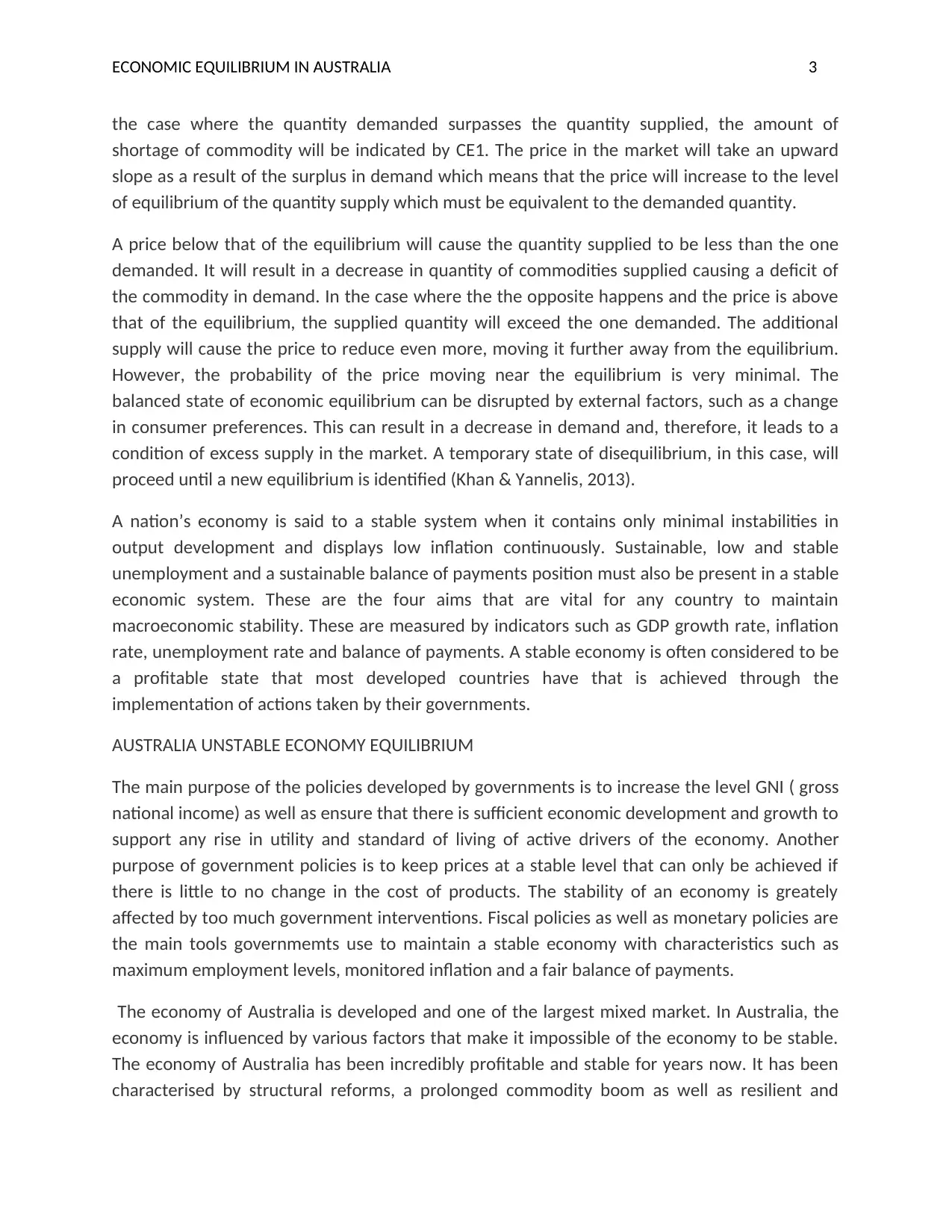
ECONOMIC EQUILIBRIUM IN AUSTRALIA 3
the case where the quantity demanded surpasses the quantity supplied, the amount of
shortage of commodity will be indicated by CE1. The price in the market will take an upward
slope as a result of the surplus in demand which means that the price will increase to the level
of equilibrium of the quantity supply which must be equivalent to the demanded quantity.
A price below that of the equilibrium will cause the quantity supplied to be less than the one
demanded. It will result in a decrease in quantity of commodities supplied causing a deficit of
the commodity in demand. In the case where the the opposite happens and the price is above
that of the equilibrium, the supplied quantity will exceed the one demanded. The additional
supply will cause the price to reduce even more, moving it further away from the equilibrium.
However, the probability of the price moving near the equilibrium is very minimal. The
balanced state of economic equilibrium can be disrupted by external factors, such as a change
in consumer preferences. This can result in a decrease in demand and, therefore, it leads to a
condition of excess supply in the market. A temporary state of disequilibrium, in this case, will
proceed until a new equilibrium is identified (Khan & Yannelis, 2013).
A nation’s economy is said to a stable system when it contains only minimal instabilities in
output development and displays low inflation continuously. Sustainable, low and stable
unemployment and a sustainable balance of payments position must also be present in a stable
economic system. These are the four aims that are vital for any country to maintain
macroeconomic stability. These are measured by indicators such as GDP growth rate, inflation
rate, unemployment rate and balance of payments. A stable economy is often considered to be
a profitable state that most developed countries have that is achieved through the
implementation of actions taken by their governments.
AUSTRALIA UNSTABLE ECONOMY EQUILIBRIUM
The main purpose of the policies developed by governments is to increase the level GNI ( gross
national income) as well as ensure that there is sufficient economic development and growth to
support any rise in utility and standard of living of active drivers of the economy. Another
purpose of government policies is to keep prices at a stable level that can only be achieved if
there is little to no change in the cost of products. The stability of an economy is greately
affected by too much government interventions. Fiscal policies as well as monetary policies are
the main tools governmemts use to maintain a stable economy with characteristics such as
maximum employment levels, monitored inflation and a fair balance of payments.
The economy of Australia is developed and one of the largest mixed market. In Australia, the
economy is influenced by various factors that make it impossible of the economy to be stable.
The economy of Australia has been incredibly profitable and stable for years now. It has been
characterised by structural reforms, a prolonged commodity boom as well as resilient and
the case where the quantity demanded surpasses the quantity supplied, the amount of
shortage of commodity will be indicated by CE1. The price in the market will take an upward
slope as a result of the surplus in demand which means that the price will increase to the level
of equilibrium of the quantity supply which must be equivalent to the demanded quantity.
A price below that of the equilibrium will cause the quantity supplied to be less than the one
demanded. It will result in a decrease in quantity of commodities supplied causing a deficit of
the commodity in demand. In the case where the the opposite happens and the price is above
that of the equilibrium, the supplied quantity will exceed the one demanded. The additional
supply will cause the price to reduce even more, moving it further away from the equilibrium.
However, the probability of the price moving near the equilibrium is very minimal. The
balanced state of economic equilibrium can be disrupted by external factors, such as a change
in consumer preferences. This can result in a decrease in demand and, therefore, it leads to a
condition of excess supply in the market. A temporary state of disequilibrium, in this case, will
proceed until a new equilibrium is identified (Khan & Yannelis, 2013).
A nation’s economy is said to a stable system when it contains only minimal instabilities in
output development and displays low inflation continuously. Sustainable, low and stable
unemployment and a sustainable balance of payments position must also be present in a stable
economic system. These are the four aims that are vital for any country to maintain
macroeconomic stability. These are measured by indicators such as GDP growth rate, inflation
rate, unemployment rate and balance of payments. A stable economy is often considered to be
a profitable state that most developed countries have that is achieved through the
implementation of actions taken by their governments.
AUSTRALIA UNSTABLE ECONOMY EQUILIBRIUM
The main purpose of the policies developed by governments is to increase the level GNI ( gross
national income) as well as ensure that there is sufficient economic development and growth to
support any rise in utility and standard of living of active drivers of the economy. Another
purpose of government policies is to keep prices at a stable level that can only be achieved if
there is little to no change in the cost of products. The stability of an economy is greately
affected by too much government interventions. Fiscal policies as well as monetary policies are
the main tools governmemts use to maintain a stable economy with characteristics such as
maximum employment levels, monitored inflation and a fair balance of payments.
The economy of Australia is developed and one of the largest mixed market. In Australia, the
economy is influenced by various factors that make it impossible of the economy to be stable.
The economy of Australia has been incredibly profitable and stable for years now. It has been
characterised by structural reforms, a prolonged commodity boom as well as resilient and
⊘ This is a preview!⊘
Do you want full access?
Subscribe today to unlock all pages.

Trusted by 1+ million students worldwide
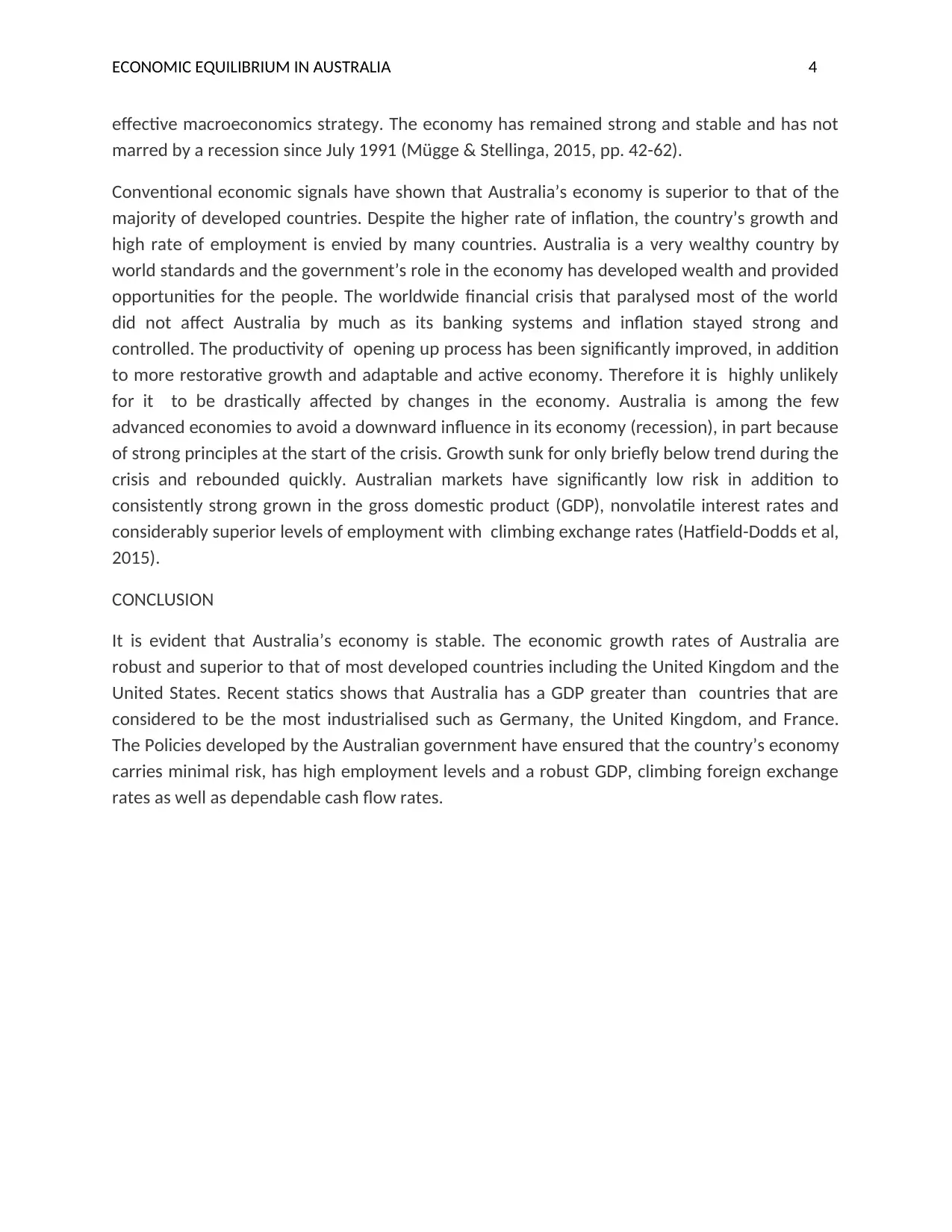
ECONOMIC EQUILIBRIUM IN AUSTRALIA 4
effective macroeconomics strategy. The economy has remained strong and stable and has not
marred by a recession since July 1991 (Mügge & Stellinga, 2015, pp. 42-62).
Conventional economic signals have shown that Australia’s economy is superior to that of the
majority of developed countries. Despite the higher rate of inflation, the country’s growth and
high rate of employment is envied by many countries. Australia is a very wealthy country by
world standards and the government’s role in the economy has developed wealth and provided
opportunities for the people. The worldwide financial crisis that paralysed most of the world
did not affect Australia by much as its banking systems and inflation stayed strong and
controlled. The productivity of opening up process has been significantly improved, in addition
to more restorative growth and adaptable and active economy. Therefore it is highly unlikely
for it to be drastically affected by changes in the economy. Australia is among the few
advanced economies to avoid a downward influence in its economy (recession), in part because
of strong principles at the start of the crisis. Growth sunk for only briefly below trend during the
crisis and rebounded quickly. Australian markets have significantly low risk in addition to
consistently strong grown in the gross domestic product (GDP), nonvolatile interest rates and
considerably superior levels of employment with climbing exchange rates (Hatfield-Dodds et al,
2015).
CONCLUSION
It is evident that Australia’s economy is stable. The economic growth rates of Australia are
robust and superior to that of most developed countries including the United Kingdom and the
United States. Recent statics shows that Australia has a GDP greater than countries that are
considered to be the most industrialised such as Germany, the United Kingdom, and France.
The Policies developed by the Australian government have ensured that the country’s economy
carries minimal risk, has high employment levels and a robust GDP, climbing foreign exchange
rates as well as dependable cash flow rates.
effective macroeconomics strategy. The economy has remained strong and stable and has not
marred by a recession since July 1991 (Mügge & Stellinga, 2015, pp. 42-62).
Conventional economic signals have shown that Australia’s economy is superior to that of the
majority of developed countries. Despite the higher rate of inflation, the country’s growth and
high rate of employment is envied by many countries. Australia is a very wealthy country by
world standards and the government’s role in the economy has developed wealth and provided
opportunities for the people. The worldwide financial crisis that paralysed most of the world
did not affect Australia by much as its banking systems and inflation stayed strong and
controlled. The productivity of opening up process has been significantly improved, in addition
to more restorative growth and adaptable and active economy. Therefore it is highly unlikely
for it to be drastically affected by changes in the economy. Australia is among the few
advanced economies to avoid a downward influence in its economy (recession), in part because
of strong principles at the start of the crisis. Growth sunk for only briefly below trend during the
crisis and rebounded quickly. Australian markets have significantly low risk in addition to
consistently strong grown in the gross domestic product (GDP), nonvolatile interest rates and
considerably superior levels of employment with climbing exchange rates (Hatfield-Dodds et al,
2015).
CONCLUSION
It is evident that Australia’s economy is stable. The economic growth rates of Australia are
robust and superior to that of most developed countries including the United Kingdom and the
United States. Recent statics shows that Australia has a GDP greater than countries that are
considered to be the most industrialised such as Germany, the United Kingdom, and France.
The Policies developed by the Australian government have ensured that the country’s economy
carries minimal risk, has high employment levels and a robust GDP, climbing foreign exchange
rates as well as dependable cash flow rates.
Paraphrase This Document
Need a fresh take? Get an instant paraphrase of this document with our AI Paraphraser
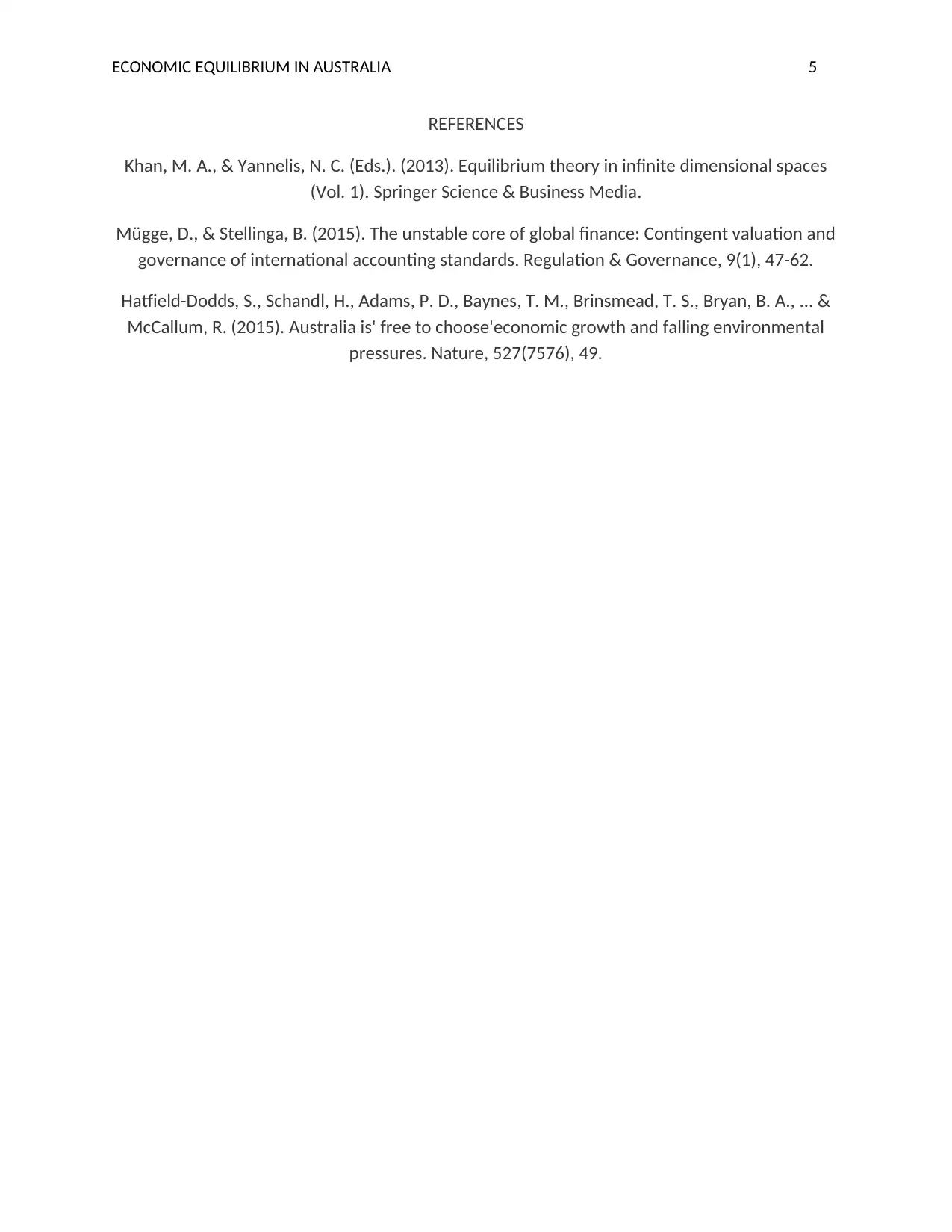
ECONOMIC EQUILIBRIUM IN AUSTRALIA 5
REFERENCES
Khan, M. A., & Yannelis, N. C. (Eds.). (2013). Equilibrium theory in infinite dimensional spaces
(Vol. 1). Springer Science & Business Media.
Mügge, D., & Stellinga, B. (2015). The unstable core of global finance: Contingent valuation and
governance of international accounting standards. Regulation & Governance, 9(1), 47-62.
Hatfield-Dodds, S., Schandl, H., Adams, P. D., Baynes, T. M., Brinsmead, T. S., Bryan, B. A., ... &
McCallum, R. (2015). Australia is' free to choose'economic growth and falling environmental
pressures. Nature, 527(7576), 49.
REFERENCES
Khan, M. A., & Yannelis, N. C. (Eds.). (2013). Equilibrium theory in infinite dimensional spaces
(Vol. 1). Springer Science & Business Media.
Mügge, D., & Stellinga, B. (2015). The unstable core of global finance: Contingent valuation and
governance of international accounting standards. Regulation & Governance, 9(1), 47-62.
Hatfield-Dodds, S., Schandl, H., Adams, P. D., Baynes, T. M., Brinsmead, T. S., Bryan, B. A., ... &
McCallum, R. (2015). Australia is' free to choose'economic growth and falling environmental
pressures. Nature, 527(7576), 49.
1 out of 5
Related Documents
Your All-in-One AI-Powered Toolkit for Academic Success.
+13062052269
info@desklib.com
Available 24*7 on WhatsApp / Email
![[object Object]](/_next/static/media/star-bottom.7253800d.svg)
Unlock your academic potential
Copyright © 2020–2025 A2Z Services. All Rights Reserved. Developed and managed by ZUCOL.





